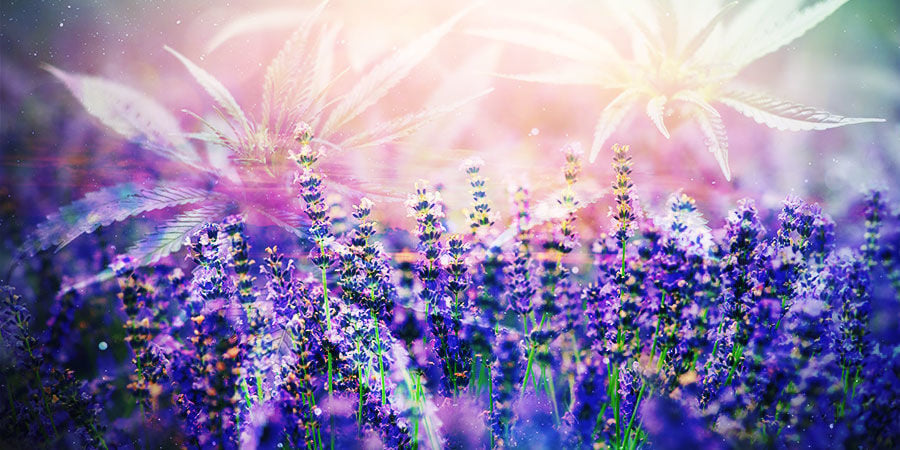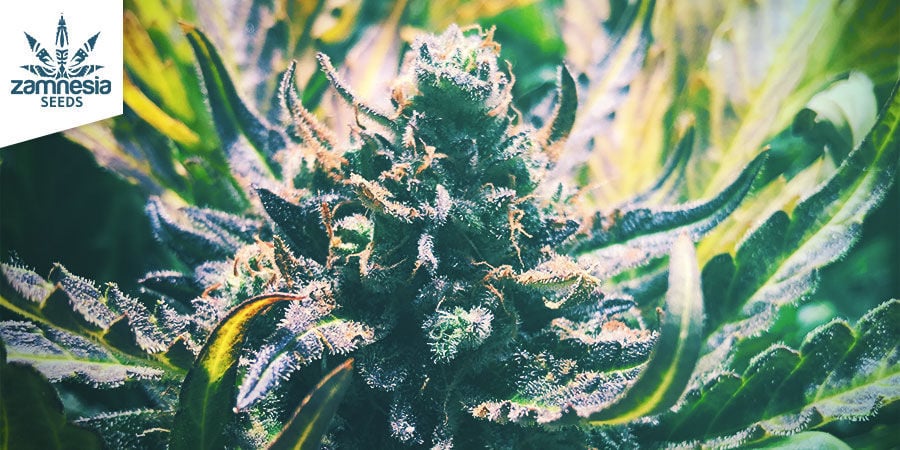
What Is Linalool And How Does It Interact With Cannabis?
The chemical constituents of cannabis don't begin and end with cannabinoids. Terpenes are another chemical class that displays some amazing potential. Linalool is one of these amazing terpenes.
Terpenes are aromatic molecules found all throughout the plant (and animal) kingdom. The pleasant and potent smells that grace the olfactory system when strolling through a pine forest or biting into a juicy segment of grapefruit is largely down to these volatile compounds. They are also responsible for the distinct and signature smells of cannabis. Varying levels of these molecules in different cannabis "chemovars" (cultivars with distinct chemical constituents) is the reason why strains smell different, taste different, and even produce different physiological effects from one another. Linalool is one such terpene that will be instantly recognisable to some, and that has a strong presence in certain cannabis strains.
Before taking a deep dive into the unique potential and features of linalool, let’s examine the relationship between cannabis and terpenes in general.
HOW TERPENES IMPACT THE CANNABIS HIGH
It’s long been known that the cannabinoid THC (tetrahydrocannabinol) is responsible for the psychoactive high induced when smoking cannabis flowers. Other cannabinoids such as CBD (cannabidiol) and CBN (cannabinol) are now also associated with effects that can influence the user's state of mind by promoting clarity and relaxation, without producing intoxication. However, advancements in scientific research have revealed nuances that make the psychoactive story of cannabis much more complex—and terpenes are a major character.
Working in unison, terpenes may help to elevate mood. In fact, a practice known as forest bathing (hiking through a forest with relaxation as an intention) is thought to be beneficial for human health due to the shower of terpenes perceived while basking in the natural aromas.
Terpenes are thought to play a significant role in both the psychoactivity and physical effects of cannabis as well. In addition to producing their own distinct effects, research shows they work in a synergistic manner with cannabinoids and, in doing so, enhance their properties. This phenomenon has been coined the entourage effect.
Terpenes play an important role in cannabis plants. They are produced as secondary metabolites by the same glandular trichomes that pump out cannabinoids. In an effort to repel predators and attract pollinators, these structures exude a resin rich in pungent terpenes.
Cannabis terpenes can be divided into two primary groups: Monoterpenes are a class that features two isoprene units and are highly bioavailable via inhalation, making their effects apparent when smoking. These include myrcene, ocimene, and limonene. Sesquiterpenes, on the other hand, are a class of terpenes that features three isoprene units, and includes caryophyllene and humulene.
HOW CAN YOU BENEFIT FROM LINALOOL?

The monoterpene linalool is a molecule with intriguing potential. Linalool is highly aromatic, contributing to the recognisable scents of lavender, basil, and roses.
Linalool has displayed synergistic relationships with certain cannabinoids, and may enhance the effects of some of these compounds. Research states that linalool may boost the muscle-relaxing effects of THC.
As well as being a key player in the entourage effect, linalool has displayed some impressive qualities when studied in isolation. Let's take a look at the different ways linalool can benefit your mind and body.
CAN LINALOOL EASE TENSION?

Have you ever placed a few drops of lavender oil into a bath and felt all of your tension and worries melt away? Or maybe you’ve smoked a particular strain of cannabis that has significantly elevated your mood? This might be thanks to the presence of linalool.
Essential oils have been used throughout history to induce a shift in psychological state, particularly in cases of meditation and prayer. Linalool may have played a role here due to its relaxing qualities. Research published in the journal Phytomedicine suggests that the terpene produces effects that soothe tension.
The research aimed to investigate the effects of inhaled linalool on tension, aggressiveness, and social interaction in mice. Indeed, the results showed that the terpene helped to relieve tension.
CAN LINALOOL CHEER YOU UP?

Litsea glaucescens, also referred to as Mexican bay leaf, is a shrub native to Mexico that’s used because it is beneficial to one's state of mind. The active components in Mexican bay leaf's essential oil are linalool and pinene.
Research published in the Journal of Ethnopharmacology investigated the comforting effects of this essential oil by administering it to mice. The preparation displayed enlivening effects in mice at doses of 100 and 300mg/kg. These results led the researchers to conclude that Mexican bay leaf may indeed help when you are feeling down.
THESE CANNABIS STRAINS ARE SUPERB SOURCES OF LINALOOL

After learning about some of linalool's intriguing properties, you may be interested to hear that certain cannabis strains contain greater levels of this soothing terpene than others!
Amnesia Haze is a superb source of linalool. This award-winning variety is sativa-dominant and produces high levels of THC and medium levels of CBD. The high is very motivating and energetic, and makes for the perfect daytime smoke when looking to accomplish tasks. Each hit is infused with refreshing hints of linalool. This strain grows to a medium height both indoors and outdoors, and has a long flowering time of 12–13 weeks. Indoor plants offer a yield of 600g/m², and a single outdoor plant will produce up to 650g.
These genetics are also available in autoflowering format thanks to Amnesia Haze Automatic. This lady induces the same sativa high and refreshing smell as the original, and has also won awards for her impressive effects and yields. These buds possess medium levels of both THC and CBD. Indoor and outdoor plants grow to a height of 150cm, and will be ready to harvest a mere 10–11 weeks after germination. Indoor plants are capable of yielding 500g/m², whereas an outdoor specimen will provide around 150g.
- (n.d.). - https://www.researchgate.net
- (n.d.). - https://www.researchgate.net
- (2012/09/28). Antidepressant activity of Litsea glaucescens essential oil: Identification of β-pinene and linalool as active principles - ScienceDirect - https://www.sciencedirect.com
- Ethan B Russo. (2011, August). Taming THC: potential cannabis synergy and phytocannabinoid-terpenoid entourage effects - https://www.ncbi.nlm.nih.gov
-
 2 min
13 June 2019
What Are Flavonoids?
Flavonoids play many roles in plant development; colour in flowers to attract insects for pollination, UV filtration, nitrogen fixation, and pest and fungi prevention. In the case of cannabis,...
2 min
13 June 2019
What Are Flavonoids?
Flavonoids play many roles in plant development; colour in flowers to attract insects for pollination, UV filtration, nitrogen fixation, and pest and fungi prevention. In the case of cannabis,...
-
 4 min
30 May 2018
Everything You Need To Know About Terpenes
If terpenes and terpenoids sound the same to you, that's because, for the most part, they are. But there is a small difference between these two compounds; terpenes are pure hydrocarbons....
4 min
30 May 2018
Everything You Need To Know About Terpenes
If terpenes and terpenoids sound the same to you, that's because, for the most part, they are. But there is a small difference between these two compounds; terpenes are pure hydrocarbons....
-
 2 min
20 August 2015
Terpene Boost: How To Grow Real Skunky Weed
The smell and taste of weed is unmistakable. Here are some steps you can take to boost this unique flavour, and really take your stash to the next level.
2 min
20 August 2015
Terpene Boost: How To Grow Real Skunky Weed
The smell and taste of weed is unmistakable. Here are some steps you can take to boost this unique flavour, and really take your stash to the next level.









 United States
United States













